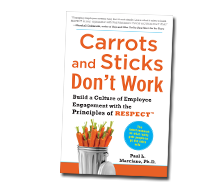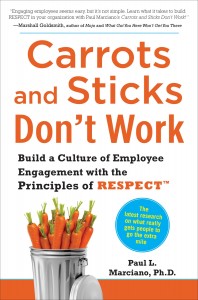Carrots & Sticks Don’t Work – by Paul L. Marciano, Ph.D.
Dr. Marciano begins his book by explaining the need for employee engagement and please note: engagement is not motivation.
The author illustrates that motivation is what gets you going, and engagement is what keeps you going. Behaviours that change quickly also change back quickly. He also acknowledges that the factors that motivate employees have changed over time, and that now “the new deal” is that there isn’t any deal – employees will leave for a better opportunity without hesitation.
The book goes on to explain what reward and recognition programs don’t work. The reader is offered 20 reasons that include:
- Rewards are not necessarily reinforcing
- Goals can limit performance
- Inconsistent and unfair administration
- Programs destroy teamwork and foster cheating
- Programs reduce creativity and risk taking
- Programs have no impact on workplace culture
In Chapter 4, we arrive at Dr. Marciano’s RESPECT ™ Model: Building a Culture of Employee Engagement. The RESPECT™ Model is an actionable philosophy based on the simple principle that when people are treated with respect they engage and work harder to achieve the goals of the organization. “An actionable philosophy is a set of values and beliefs intended to guide one’s daily actions and behaviours, for example, the Golden Rule,
which teaches people to treat one another as they would want to be treated.”
The Circle of RESPECT
The “Circle of RESPECT” distinguishes five areas in which employees experience feelings of respect and disrespect (organization, individual, work, team and supervisor), and the book offers numerous practical examples of how to integrate these ideas in an organization.
Seven Drivers of the RESPECT™ Model
In his research, Dr. Marciano identified respect as the central driving force behind engagement, as well as several specific factors that cause employees to feel respected. The book also examines factors that increase and decrease employee engagement.
The final chapter is devoted to how to implement the RESPECT™ model, given the author’s perception that there is a general decline of respect in society. Turnkey strategies and best practices are offered for each model component, which include leading with RESPECT. People follow leaders they respect and leaders who respect them. Respected leaders inspire followers to engage in the work that needs to be done to fulfill the mission and vision of the organization. And what benefits should one expect from implementing this tool?
In Summary:
Dr. Marciano believes that the traditional model of rewards and punishment can get results in the short-term; long-term, sustainable impact and results come from building respect.
His step-by-step process is intended to be used inside and outside of work, and garner loyalty, discretionary effort and commitment through respect. Like any significant improvement, the “tone from the top” via consistent example is mandatory. The anticipated outcome of implementing the RESPECT™ model:
- A more effective organization
- Reduced turnover and absenteeism
- Employees at all levels who are engaged, focused and committed to succeed as a team
In short, “you get your, maximum Return on Investment (ROI) from your organization’s most powerful resource, its people!”


